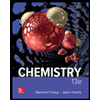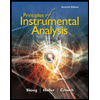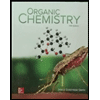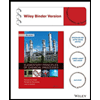
Connect 2-Year Online Access for General, Organic, and Biochemistry
9th Edition
ISBN: 9781259677946
Author: Denniston
Publisher: Mcgraw-hill Higher Education (us)
expand_more
expand_more
format_list_bulleted
Concept explainers
Question
Chapter 1, Problem 1.63QP
Interpretation Introduction
Interpretation:
Mass belongs to which property of matter has to be given.
Expert Solution & Answer
Want to see the full answer?
Check out a sample textbook solution
Students have asked these similar questions
draw the major product formed with the listed reagents
Propose Williamson ether syntheses for the following compounds
Identify all functional groups
Chapter 1 Solutions
Connect 2-Year Online Access for General, Organic, and Biochemistry
Ch. 1.1 - Prob. 1.1PPCh. 1.2 - Is each of the following materials a pure...Ch. 1.2 - Intravenous therapy may be used to introduce a...Ch. 1.2 - Cloudy urine can be a symptom of a bladder...Ch. 1.2 - Classify each of the following as either a...Ch. 1.2 - Prob. 1.3QCh. 1.2 - Prob. 1.4QCh. 1.2 - Prob. 1.4PPCh. 1.2 - Label each property as intensive or extensive:
the...Ch. 1.2 - Label each property as intensive or extensive:
the...
Ch. 1.4 - How many significant figures are contained in each...Ch. 1.4 - Prob. 1.8QCh. 1.4 - Prob. 1.9QCh. 1.4 - Prob. 1.10QCh. 1.4 - Prob. 1.11QCh. 1.4 - Prob. 1.12QCh. 1.4 - Prob. 1.13QCh. 1.4 - Prob. 1.14QCh. 1.4 - Prob. 1.5PPCh. 1.4 - Prob. 1.15QCh. 1.4 - Prob. 1.16QCh. 1.4 - Prob. 1.6PPCh. 1.4 - Prob. 1.17QCh. 1.4 - Prob. 1.18QCh. 1.5 - Convert 360 ft to mi.
Ch. 1.5 - Convert:
750 cm to mm
1.5 × 108 μL to cL
0.00055...Ch. 1.5 - Convert:
0.50 in to m
0.75 qt to L
56.8 g to...Ch. 1.5 - Convert:
1.5 cm2 to m2
3.6 m2 to cm2
Ch. 1.5 - Convert 0.791 g/mL to kg/L.
Ch. 1.6 - The freezing temperature of water is 32°F....Ch. 1.6 - Prob. 1.19QCh. 1.6 - Prob. 1.20QCh. 1.6 - Prob. 1.13PPCh. 1.6 - Prob. 1.14PPCh. 1.6 - Prob. 1.15PPCh. 1.6 - Calculate the volume, in mL, of 10.0 g of a saline...Ch. 1 - Define chemistry and explain how burning wood is...Ch. 1 - Prob. 1.22QPCh. 1 - Why is experimentation an important part of the...Ch. 1 - Prob. 1.24QPCh. 1 - What data would be required to estimate the total...Ch. 1 - What data would be required to estimate the mass...Ch. 1 - What are the characteristics of methane emphasized...Ch. 1 - Discuss the difference between hypothesis and...Ch. 1 - Discuss the difference between theory and...Ch. 1 - We use aspects of the scientific method in our...Ch. 1 - Experimentation has shown that stem cell research...Ch. 1 - Observed increases in global temperatures are...Ch. 1 - Prob. 1.35QPCh. 1 - List the three states of matter.
Ch. 1 - Explain the differences among the three states of...Ch. 1 - Prob. 1.39QPCh. 1 - Prob. 1.40QPCh. 1 - Prob. 1.41QPCh. 1 - Prob. 1.42QPCh. 1 - Prob. 1.43QPCh. 1 - Prob. 1.44QPCh. 1 - Explain the difference between chemical properties...Ch. 1 - List the differences between chemical changes and...Ch. 1 - Label each of the following as pertaining to...Ch. 1 - Prob. 1.48QPCh. 1 - Prob. 1.49QPCh. 1 - Prob. 1.50QPCh. 1 - Label each of the following as either a physical...Ch. 1 - Prob. 1.52QPCh. 1 - Label each of the following properties of sodium...Ch. 1 - Prob. 1.54QPCh. 1 - Label each of the following as either a pure...Ch. 1 - Prob. 1.56QPCh. 1 - Label each of the following as either a...Ch. 1 - Prob. 1.58QPCh. 1 - Prob. 1.59QPCh. 1 - Prob. 1.60QPCh. 1 - Prob. 1.61QPCh. 1 - Mass is the measure of what property of matter?
Ch. 1 - Explain the difference between mass and weight.
Ch. 1 - Prob. 1.65QPCh. 1 - Prob. 1.66QPCh. 1 - How is the metric unit of L defined?
Ch. 1 - What English unit of volume is similar to a L?
Ch. 1 - Rank the following from shortest to longest...Ch. 1 - Rank the following from least to greatest mass.
Ch. 1 - Determine the temperature reading of the following...Ch. 1 - Prob. 1.72QPCh. 1 - Prob. 1.73QPCh. 1 - Prob. 1.74QPCh. 1 - How many significant figures are represented in...Ch. 1 - Prob. 1.76QPCh. 1 - Round the following numbers to three significant...Ch. 1 - Round the following numbers to three significant...Ch. 1 - Perform each of the following operations,...Ch. 1 - Prob. 1.80QPCh. 1 - Prob. 1.81QPCh. 1 - Prob. 1.82QPCh. 1 - Prob. 1.83QPCh. 1 - Prob. 1.84QPCh. 1 - Prob. 1.85QPCh. 1 - Prob. 1.86QPCh. 1 - Give the abbreviation and meaning of the following...Ch. 1 - Fill in the blank with the missing abbreviation...Ch. 1 - Write the two conversion factors that can be...Ch. 1 - Write the two conversion factors that can be...Ch. 1 - Prob. 1.91QPCh. 1 - Prob. 1.92QPCh. 1 - Prob. 1.93QPCh. 1 - Prob. 1.94QPCh. 1 - Convert 1.50 × 104 μg to mg.
Ch. 1 - Prob. 1.96QPCh. 1 - A typical office has 144 ft2 of floor space....Ch. 1 - Prob. 1.98QPCh. 1 - Prob. 1.99QPCh. 1 - Prob. 1.100QPCh. 1 - Prob. 1.101QPCh. 1 - Prob. 1.102QPCh. 1 - Prob. 1.103QPCh. 1 - Prob. 1.104QPCh. 1 - Which mass is smaller: 5.0 mg or 5.0 μg?
Ch. 1 - Which volume is smaller: 1.0 L or 1.0 qt?
Ch. 1 - Prob. 1.107QPCh. 1 - Prob. 1.108QPCh. 1 - Prob. 1.109QPCh. 1 - Prob. 1.110QPCh. 1 - Prob. 1.111QPCh. 1 - Prob. 1.112QPCh. 1 - Prob. 1.113QPCh. 1 - Prob. 1.114QPCh. 1 - Convert 50.0°F to:
°C
K
Ch. 1 - The weather station posted that the low for the...Ch. 1 - The thermostat shows that the room temperature is...Ch. 1 - Convert 300.0 K to:
°C
°F
Ch. 1 - Prob. 1.119QPCh. 1 - Prob. 1.120QPCh. 1 - Calculate the density of a 3.00 × 102 g object...Ch. 1 - Calculate the density of 50.0 g of an isopropyl...Ch. 1 - What volume, in L, will 8.00 × 102 g of air occupy...Ch. 1 - Prob. 1.124QPCh. 1 - What is the mass, in g, of a piece of iron that...Ch. 1 - What is the mass of a femur (leg bone) having a...Ch. 1 - For the treatment of cystic fibrosis, it has been...Ch. 1 - You are given a piece of wood that is either...Ch. 1 - You are given three bars of metal. Each is labeled...Ch. 1 - Refer to Question 1.135. Suppose that each of the...Ch. 1 - The density of methanol at 20°C is 0.791 g/mL....Ch. 1 - The density of methanol at 20°C is 0.791 g/mL....Ch. 1 - Prob. 1.133QPCh. 1 - The specific gravity of a patient’s urine sample...Ch. 1 - The density of grain alcohol is 0.789 g/mL. Given...Ch. 1 - Prob. 1.136QPCh. 1 - The density of whole human blood in a healthy...Ch. 1 - Prob. 1.138QPCh. 1 - An instrument used to detect metals in drinking...Ch. 1 - Prob. 2CPCh. 1 - Aspirin has been recommended to minimize the...Ch. 1 - The diameter of an aluminum atom is 250 picometers...
Knowledge Booster
Learn more about
Need a deep-dive on the concept behind this application? Look no further. Learn more about this topic, chemistry and related others by exploring similar questions and additional content below.Similar questions
- A mixture of CaCO3 and MgC2O4 of unknown mass was heated in a 0.5 L closed rigid vessel to 900 degrees C.at 400C the following reaction occurs:MgC2O4 -> MgO (s) + CO (g) + CO2 (g)At 700C a second reaction occurs: CaCO3 -> CaO (s) + CO2 (g)The solid mass in the vessel was measured to be 3.06 g at 400C and 2.03g at 900CQuestion: What is the partial pressure of CO in both temperatures? (400 and 900C), provide detailed explanation.arrow_forwardFor the following alkyne, complete the reaction sequentially (that is draw the intermediate that we can’t stop at) and then name (complete name) all 3 molecules.arrow_forwardGiven the reaction sequence below, answer the following. A. Provide the structure for A. B. Provide the structure for B (pay attention to stereochemistry). C. Provide the structure for C. D. What are the stereochemical designations for I and II (R/S)?arrow_forward
- There are 2 reactions (that you know of) to achieve the following transformation: One reaction is favored over the other because it avoids a competing reaction. A. Draw the favored reaction scheme (not the mechanism), be sure to include all necessary reagents. B. Draw the reaction scheme that is not favored and include all the possible products.arrow_forwardBoth carbocations and carbon-radicals have trigonal planar geometry. True or Falsearrow_forwardTeflon (polytetrafluoroethene) is prepared via the radial polymerization of tetrafluoroethene. What other reaction conditions (reagent, etc.) are needed to accomplish this? A. NBS, Light B. Heat, Cl2 C. Peroxide, Heat D. H2SO4, H2O, Heatarrow_forward
- Which of the following compounds can be reacted with ethene to prepare 1,1- dichlorocyclopropane? A. CCl4 B. CCl2 C. CHCl3 D. CH2Cl2arrow_forwardusing any reactions, starting with propene, propose a synthesis for the following moleculearrow_forwardFor a free radical bromination reaction, the stereochemistry of the product is easily controlled True OR Falsearrow_forward
arrow_back_ios
SEE MORE QUESTIONS
arrow_forward_ios
Recommended textbooks for you
 ChemistryChemistryISBN:9781305957404Author:Steven S. Zumdahl, Susan A. Zumdahl, Donald J. DeCostePublisher:Cengage Learning
ChemistryChemistryISBN:9781305957404Author:Steven S. Zumdahl, Susan A. Zumdahl, Donald J. DeCostePublisher:Cengage Learning ChemistryChemistryISBN:9781259911156Author:Raymond Chang Dr., Jason Overby ProfessorPublisher:McGraw-Hill Education
ChemistryChemistryISBN:9781259911156Author:Raymond Chang Dr., Jason Overby ProfessorPublisher:McGraw-Hill Education Principles of Instrumental AnalysisChemistryISBN:9781305577213Author:Douglas A. Skoog, F. James Holler, Stanley R. CrouchPublisher:Cengage Learning
Principles of Instrumental AnalysisChemistryISBN:9781305577213Author:Douglas A. Skoog, F. James Holler, Stanley R. CrouchPublisher:Cengage Learning Organic ChemistryChemistryISBN:9780078021558Author:Janice Gorzynski Smith Dr.Publisher:McGraw-Hill Education
Organic ChemistryChemistryISBN:9780078021558Author:Janice Gorzynski Smith Dr.Publisher:McGraw-Hill Education Chemistry: Principles and ReactionsChemistryISBN:9781305079373Author:William L. Masterton, Cecile N. HurleyPublisher:Cengage Learning
Chemistry: Principles and ReactionsChemistryISBN:9781305079373Author:William L. Masterton, Cecile N. HurleyPublisher:Cengage Learning Elementary Principles of Chemical Processes, Bind...ChemistryISBN:9781118431221Author:Richard M. Felder, Ronald W. Rousseau, Lisa G. BullardPublisher:WILEY
Elementary Principles of Chemical Processes, Bind...ChemistryISBN:9781118431221Author:Richard M. Felder, Ronald W. Rousseau, Lisa G. BullardPublisher:WILEY

Chemistry
Chemistry
ISBN:9781305957404
Author:Steven S. Zumdahl, Susan A. Zumdahl, Donald J. DeCoste
Publisher:Cengage Learning

Chemistry
Chemistry
ISBN:9781259911156
Author:Raymond Chang Dr., Jason Overby Professor
Publisher:McGraw-Hill Education

Principles of Instrumental Analysis
Chemistry
ISBN:9781305577213
Author:Douglas A. Skoog, F. James Holler, Stanley R. Crouch
Publisher:Cengage Learning

Organic Chemistry
Chemistry
ISBN:9780078021558
Author:Janice Gorzynski Smith Dr.
Publisher:McGraw-Hill Education

Chemistry: Principles and Reactions
Chemistry
ISBN:9781305079373
Author:William L. Masterton, Cecile N. Hurley
Publisher:Cengage Learning

Elementary Principles of Chemical Processes, Bind...
Chemistry
ISBN:9781118431221
Author:Richard M. Felder, Ronald W. Rousseau, Lisa G. Bullard
Publisher:WILEY
Types of Matter: Elements, Compounds and Mixtures; Author: Professor Dave Explains;https://www.youtube.com/watch?v=dggHWvFJ8Xs;License: Standard YouTube License, CC-BY